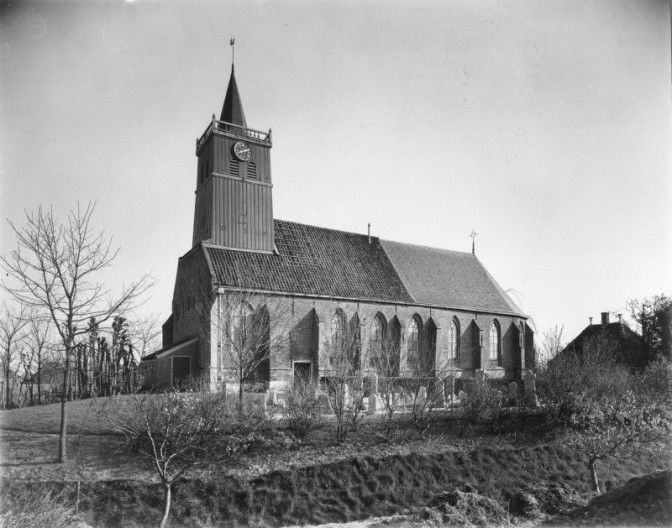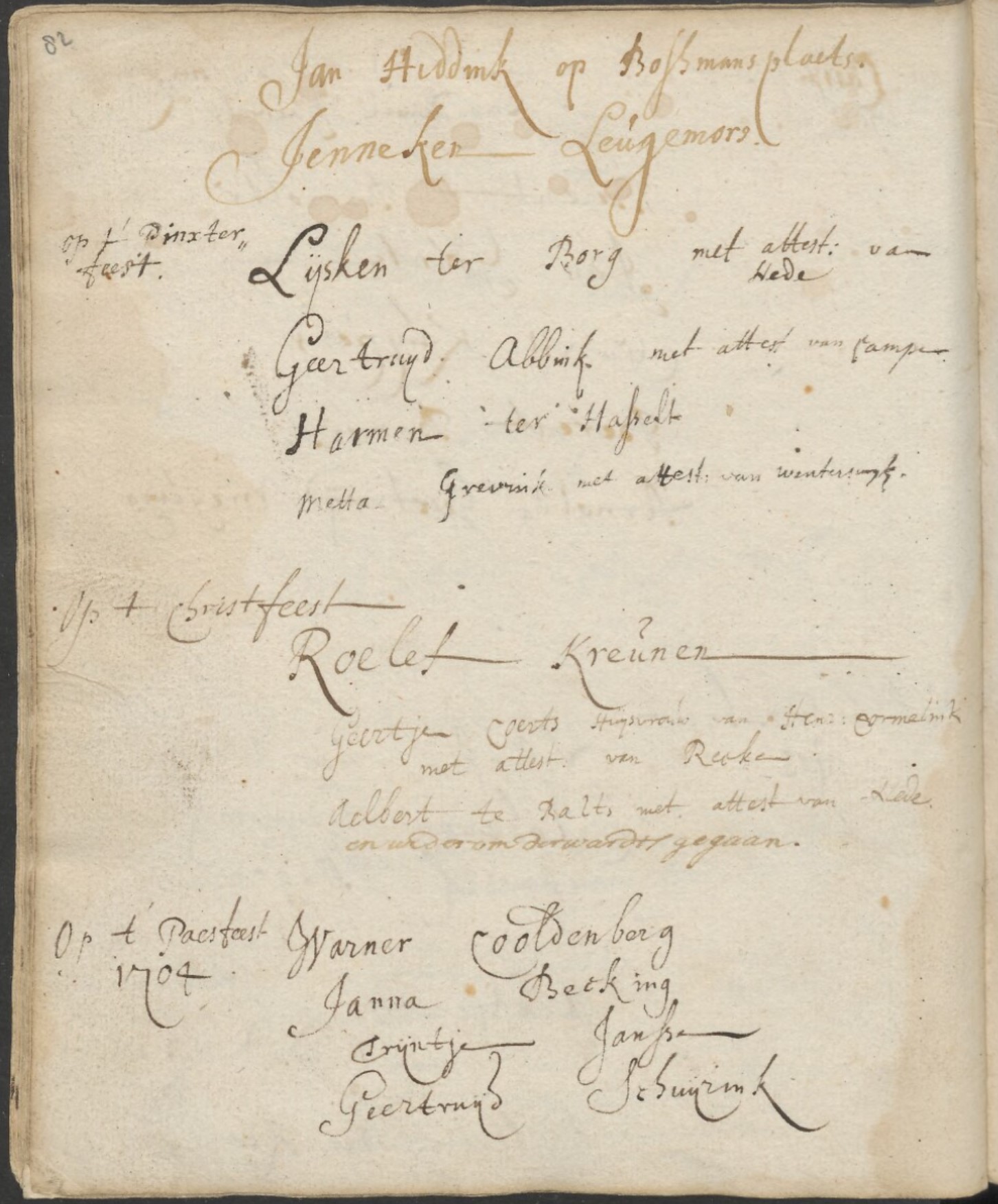Church membership records or lidmatenboeken record the members of a church.
Church membership records are typically kept by protestant churches, like the Dutch Reformed Church. In the protestant faith, people become members by confession of faith as adults. This is different than in the Roman Catholic Church, that considers people as members from the moment of baptism, often in infancy.

Dutch Reformed Church in Lambertschaag, Noord-Holland. Image credits: Rijksdienst voor het Cultureel Erfgoed (CC-BY-SA)
Structure of church membership records
Church membership records are typically kept in chronological order. There are two different types of entries:
- people who join the church by confession of faith.
- people who join the congregation from another church. These entries will often mention the previous church and whether the previous church gave them proof (“attest”) that they had already been confessed members there.
The lists do not show all people who attended service today, just the ones who became members of that congregation. Church council minutes may have more details about the members, including their unauthorized absence from services or other transgressions.
Sometimes the membership registers were updated later. If a member died, sometimes there entry was struck through, occasionally even with the death date written in the margin. Similarly, if a church member moved, their entry may have been stricken, and sometimes the next church they joined is written in the margin, possibly with a date.
Ministers occasionally made a list of every member, perhaps if the minister just joined the church and wanted to get to know his flock. These longer lists of members can often be found between the other membership records. If you see your ancestor in the membership register for the same church more than once, this is the most likely explanation. They could also have moved away and back again. The number of entries or the heading should usually tell you if you are dealing with a “census” of all members or just a list of people who joined the congregation that day.
How to use Dutch church membership records
Church membership records can help answer the following research questions:
- It may give you the previous or next place of residence, which can help to trace your ancestor.
- Knowing the church they belonged to can help you find images of the church, visit the church, or know where to look for other records, such as burials.
- It will tell you about the religion of your ancestors, and what other sources might exist. For example, if they appear in a membership register of an Anabaptist church, that does not practice infant baptism, that would explain why you have not been able to find a baptismal record.
- The record may list the spouse, if husband and wife joined at the same time.
- Other people who joined the church at the same date may have been part of the same migration, or of the same family that split from one church to join another.
- People often associated with others from the same church and often found their spouses there. Knowing the associates may help you find more information about your ancestors.
- Knowing when they first became confessed members can help you to estimate their date of birth. People were typically at least 18 years old, and many joined the church by the age of 21, though it is not uncommon to find older people.
- It establishes your person in a specific time and place. That in itself can be helpful: you can look for other records there, you know the person had not died yet, you can use it to distinguish between different people if a same-named person lived elsewhere at the same time, et cetera.
Where to find church membership records in the Netherlands
Church membership records are most often used for the period before the introduction of the civil registration, which happened in 1811 in most parts of the Netherlands. When the civil registration was introduced, churches were required to turn over their records to the government, which often included the membership records. These records are kept in government archives. Many churches have since turned over their other records to government archives, even after 1811.
Many church membership records from before 1811 have been indexed, and are available in the usual places (see Top 10 websites for Dutch Genealogy) or from government archives at the national, provincial, regional, or local level. See Digital Resources Netherlands and Belgium for links (search for “lidmaten” in the internet page for the province).
Example: Dutch Reformed Church Membership Register of Eibergen

Dutch Reformed Church Membership Register of Eibergen, 1703-1704
[heading on previous page] Easter 1703
- Jan Hidding at the Boschmansplaets [Boschmans’ farm]
- Jenneken Leugemors
Pentacost
- Lijsken ter Borg, with attestation from Nede
- Geertruijd Abbink, with attestation from Campen
- Harmen ter Hasselt
- Metta Grevink with attestation from Winterswijk
At Christmas
- Roelef Kreunen
- Geertjen Coerts wife of Henr: Cormelink with attestation from Recken
- Aelbert te Balts with attestation from Nede [other ink:] and went back there
Easter 1704
- Warner Cooldenberg
- Janna Becking
- Trijntje Jansen
- Geertruijd Schuijrink1
This is a typical example of church membership records in the eighteenth century. It does not give a great deal of personal information, but occasionally lists a spouse, a farm, or the previous or next place of residence. From the references to the attestations from previous places we can infer that the entries without such a reference, recorded on the same day by the same person, were for people who first joined the church by confession of faith.
Dutch Genealogy Source Score
 Amount of information about births, marriages, deaths
Amount of information about births, marriages, deaths
 Amount of background information about your ancestors
Amount of background information about your ancestors
 Online availability of scans
Online availability of scans
 Online availability of indexes or transcriptions
Online availability of indexes or transcriptions
 Easy to understand if you don’t know Dutch
Easy to understand if you don’t know Dutch
Source
- Dutch Reformed Church (Eibergen), membership register 1653-1760, p. 82, members easter 1703-easter 1704; call no. 48, Dutch Reformed Church of Eibergen, Record Group 0117, Erfgoedcentrum Achterhoek en Liemers, Doetinchem; finding aid and images, Erfgoedcentrum Achterhoek en Liemers (https://proxy.archieven.nl/26/9D2F828B8FD24662BE767BE4E6710B3E : accessed 19 October 2022).


For some time I have collected copies of pages of lidmatenboeken, but did not have a full understanding of the purpose of the records were. I did find the marriage of Johannes Simmer and Margrieta van Galen in 1725. As you kindly interpreted it for me, we found that Johannes was a calvary man. I have not been able to find out who his parents were or when he was born. What is further interesting, the year before a Johannes Zimmer became a member and he was from Hessenland. This would have been in Germany, but I have no proof they are the same person. Sorry for being so wordy, but thank you for this article and it did clear up some questions I had.